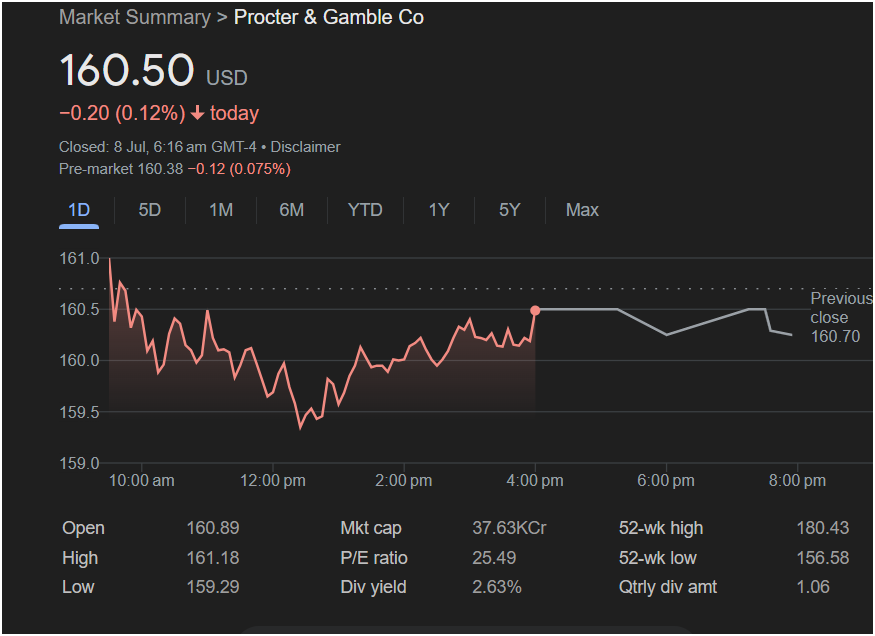Procter & Gamble (PG) Stock Under a Microscope: A Deep Dive into a Day of Intense Volatility and a Tenuous Recovery

Cincinnati, OH – The trading session on July 8th proved to be a nail-biter for investors in Procter & Gamble Co. (NYSE: PG), as the consumer staples titan was caught in a whirlwind of selling pressure before mounting a significant but incomplete comeback. The day’s stock chart tells a dramatic story of a battle between bulls and bears, ultimately ending with the stock in the red at
0.20 (0.12%). While the final figure appears minor, it masks the intraday turbulence that saw the stock swing by nearly two dollars, a notable move for a typically stable blue-chip company.
The market’s opening bell set a precarious tone. PG began trading at $160.89, slightly above its previous close of
161.18**. However, this early strength quickly evaporated. A wall of selling pressure emerged, initiating a steep and persistent decline that would define the first half of the trading day. Investors watched as the stock price systematically broke through support levels, slipping below the previous day’s close and continuing its descent.
The downward momentum culminated around midday when Procter & Gamble hit its session low of $159.29. This dip represented a critical test for the stock, bringing it closer to its 52-week low and forcing investors to question whether a more substantial correction was underway. For traders and market analysts, this moment was pivotal. The ability of the stock to find a floor at this level would be a key indicator of underlying strength and buyer interest.
And find a floor it did. In the afternoon hours, a new narrative began to unfold. Bargain hunters and institutional investors, perhaps viewing the dip as an overreaction or an attractive entry point, began to step in. The buying volume increased, reversing the morning’s sharp losses. The stock embarked on a steady climb, successfully reclaiming the psychologically important $160.00 level. This rebound demonstrated resilience and restored a degree of confidence, allowing PG to claw back the majority of its losses. However, the recovery rally lost steam as the 4:00 pm closing bell approached, failing to push the stock back into positive territory. The session closed with the stock settling at $160.50, a testament to the day’s hard-fought battle.
Further fueling investor caution, post-market activity signaled continued uncertainty. In pre-market trading, PG was quoted at $160.38, down an additional 0.075%, suggesting that the selling pressure had not fully subsided and that the stock could face another challenging open.
Beyond the Day’s Ticker: Analyzing the Fundamental Picture
To fully understand the context of this single day’s trading, it is essential to look at the fundamental metrics provided. These numbers paint a broader picture of Procter & Gamble’s valuation and its appeal to different types of investors.
Valuation and Profitability (P/E Ratio): The stock is trading with a Price-to-Earnings (P/E) ratio of 25.49. This metric, which compares the company’s stock price to its earnings per share, suggests a relatively premium valuation. For a mature, stable company in the consumer staples sector, a P/E in the mid-20s is not uncommon. It indicates that investors are willing to pay a higher price for the company’s reliable earnings and defensive business model, which tends to perform well even during economic downturns. The volatility seen today, therefore, is less likely a reaction to the company’s core profitability and more a result of broader market sentiment or technical trading patterns.
The Bedrock of an Income Portfolio (Dividend Yield): One of Procter & Gamble’s most enduring strengths is its status as a premier dividend stock. With a dividend yield of 2.63% and a quarterly dividend payment of $1.06 per share, PG remains a cornerstone for income-focused portfolios. The company is a “Dividend King,” having increased its dividend for over 65 consecutive years. This remarkable track record provides a powerful incentive for long-term investors to hold the stock through periods of volatility, as the steady income stream can help offset temporary price declines. The day’s price dip, in fact, makes the yield slightly more attractive for new buyers.
Navigating the 52-Week Range: The day’s trading activity occurred within a well-defined 52-week range. The intraday low of
156.58**. This lower boundary represents a significant technical support level, and the rebound from this area suggests that strong buying interest exists near these levels. Conversely, the 52-week high of $180.43 remains a distant target. The stock is currently trading approximately 11% below this peak, indicating that it has significant ground to recover before challenging its previous highs. This wide range highlights the broader corrective phase the stock has been in over the past year.
A Market Behemoth (Market Capitalization): The provided market cap figure of “37.63KCr” appears to be a regional display format. In more universal terms, Procter & Gamble boasts a market capitalization of approximately $385 billion, solidifying its position as one of the largest and most influential companies in the world. Its vast portfolio of trusted brands—from Tide and Pampers to Gillette and Crest—gives it immense scale and a deep moat against competitors. This size and stability are why significant intraday swings, like the one witnessed, draw considerable market attention.
As investors digest the day’s events, the focus shifts to the next session. The key question is whether the afternoon rebound was the start of a new upward trend or merely a temporary reprieve in a larger downtrend. All eyes will be on whether Procter & Gamble can hold above the crucial $160 support level and build on its late-day momentum, or if the lingering pre-market weakness will pull it back down to re-test the lows of a volatile and unforgettable trading day.

